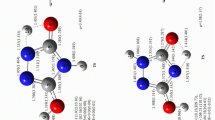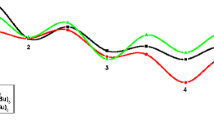Abstract
The B3LYP and wB97XD density functional methods were used to study the mechanisms and thermodynamic parameters of the activation and reactions of non-catalytic and catalyzed by phenol and p-toluenesulfonic acid reactions of urea with methylamine. The interaction proceeds stepwise with the intermediate formation of N-methylurea. The non-catalytic interaction has a large activation barrier. In the case of participation of methylamine dimer, the activation barrier decreases, but, nevertheless, remains high. During catalysis by phenol and p-toluenesulfonic acid, compounds exhibiting biphilic properties, the activation barrier decreases. The greatest decrease in the activation barrier is observed during catalysis with p-toluenesulfonic acid.













Similar content being viewed by others
Availability of data and materials
The datasets used and/or analyzed during the current study are available from the corresponding author on reasonable request.
References
Primeaux DJ II (2004) Polyurea elastomer technology: history, chemistry and basic formulating techniques. Primeaux Associates LLC, Elgin
Fuger KE, McCoy JJ, Zajacek JG (1975) Process for the manufacture of urethanes, US Patent 3,895,054 A
He Y, Xie D, Zhang X (2014) The structure, microphase-separated morphology, and property of polyurethanes and polyureas. J Mater Sci 49:7339–7352. https://doi.org/10.1007/s10853-014-8458-y
Bayer O, Siefken W, Rinke H, Orthner L, Schild H (1937) A process for the preparation of polyurethanes or polyureas, German Patent DRP 728981
Babad H, Zeiler AG (1973) Chemistry of phosgene. Chem Rev 73:75–91. https://doi.org/10.1021/cr60281a005
Cotarca L, Ecket H (2003) Phosgenations: a handbook. Wiley-VCH Verlag GmbH & Co, Weinheim
Ma S, Liu C, Sablong RJ et al (2016) Catalysts for isocyanate-free polyurea synthesis: mechanism and application. ACS Catal 6:6883–6891. https://doi.org/10.1021/acscatal.6b01673
Ma S, van Heeswijk EPA, Noordover BAJ et al (2018) Isocyanate-free approach to water-borne polyurea dispersions and coatings. Chemsuschem 11:149–158. https://doi.org/10.1002/cssc.201701930
Wu C, Cheng H, Liu R et al (2010) Synthesis of urea derivatives from amines and CO2 in the absence of catalyst and solvent. Green Chem 12:1811–1816. https://doi.org/10.1039/C0GC00059K
Wu C, Wang J, Chang P et al (2012) Polyureas from diamines and carbon dioxide: synthesis, structures and properties. Phys Chem Chem Phys 14:464–468. https://doi.org/10.1039/C1CP23332G
Okaniwa M, Takeuchi K, Asai M, Ueda M (2002) One-pot synthesis of dendritic poly(amide-urea)s via curtius rearrangement. 1. Monomer syntheses and model reactions for the dendritic poly(amide-urea)s synthesis. Macromolecules 35:6224–6231. https://doi.org/10.1021/ma020387l
Tuerp D, Bruchmann B (2015) Dendritic Polyurea Polymers. Macromol Rapid Commun 36:138–150. https://doi.org/10.1002/marc.201400510
Chaturvedi D (2012) Perspectives on the synthesis of organic carbamates. Tetrahedron 68:15–45. https://doi.org/10.1016/j.tet.2011.10.001
Filippi L, Meier MAR (2021) Fully renewable non-isocyanate polyurethanes via the lossen rearrangement. Macromol Rapid Commun 42:2000440. https://doi.org/10.1002/marc.202000440
Yamazaki N, Iguchi T, Higashi F (1979) The reaction of diphenyl carbonate with amines and its application to polymer synthesis. J Polym Sci Polym Chem Ed 17:835–841. https://doi.org/10.1002/pol.1979.170170322
Bossion A, Aguirresarobe RH, Irusta L et al (2018) Unexpected synthesis of segmented poly(hydroxyurea–urethane)s from dicyclic carbonates and diamines by organocatalysis. Macromolecules 51:5556–5566. https://doi.org/10.1021/acs.macromol.8b00731
Wu Z, Tang L, Dai J, Qu J (2019) Synthesis and properties of fluorinated non-isocyanate polyurethanes coatings with good hydrophobic and oleophobic properties. J Coat Technol Res 16:1233–1241. https://doi.org/10.1007/s11998-019-00195-5
Montarnal D, Cordier P, Soulié-Ziakovic C et al (2008) Synthesis of self-healing supramolecular rubbers from fatty acid derivatives, diethylene triamine, and urea. J Polym Sci Part A Polym Chem 46:7925–7936. https://doi.org/10.1002/pola.23094
Erickson JG (1954) Reactions of Long-chain Amines. II. Reactions with Urea1. J Am Chem Soc 76:3977–3978. https://doi.org/10.1021/ja01644a033
Tischer S, Börnhorst M, Amsler J et al (2019) Thermodynamics and reaction mechanism of urea decomposition. Phys Chem Chem Phys 21:16785–16797. https://doi.org/10.1039/C9CP01529A
Wang D, Dong N, Hui S, Niu Y (2019) Analysis of urea pyrolysis in 132.5–190 °C. Fuel 242:62–67. https://doi.org/10.1016/j.fuel.2019.01.011
Hackl KA, Falk H (1992) The synthesis of N-substituted ureas II: Nucleophilic substitution of ureas at the carbonyl group. Monatshefte für Chemie/Chem Mon 123:607–615. https://doi.org/10.1007/BF00816856
Erice A, Ruiz de Luzuriaga A, Matxain JM et al (2018) Reprocessable and recyclable crosslinked poly(urea-urethane)s based on dynamic amine/urea exchange. Polymer 145:127–136. https://doi.org/10.1016/j.polymer.2018.04.076
Erice A, Azcune I, Ruiz de Luzuriaga A et al (2019) Effect of regioisomerism on processability and mechanical properties of amine/urea exchange based poly(urea-urethane) vitrimers. ACS Appl Polym Mater 1:2472–2481. https://doi.org/10.1021/acsapm.9b00589
Frisch MJ, Trucks GW, Schlegel HB, Scuseria GE, Robb MA, Cheeseman JR, Scalmani G, Barone V, Mennucci B, Petersson GA (2009) Gaussian 09, revision A.1. Gaussian Inc, Wallingford
Becke AD (1992) Density-functional thermochemistry. I. The effect of the exchange-only gradient correction. J Chem Phys 96:2155–2160. https://doi.org/10.1063/1.462066
Becke AD (1992) Density-functional thermochemistry. II. The effect of the Perdew-Wang generalized-gradient correlation correction. J Chem Phys 97:9173–9177. https://doi.org/10.1063/1.463343
Becke AD (1993) Density-functional thermochemistry. III. The role of exact exchange. J Chem Phys 98:5648–5652. https://doi.org/10.1063/1.464913
Chai J-D, Head-Gordon M (2008) Long-range corrected hybrid density functionals with damped atom–atom dispersion corrections. Phys Chem Chem Phys 10:6615–6620. https://doi.org/10.1039/B810189B
Foster JP, Weinhold F (1980) Natural hybrid orbitals. J Am Chem Soc 102:7211–7218. https://doi.org/10.1021/ja00544a007
Marenich AV, Cramer CJ, Truhlar DG (2009) Universal solvation model based on solute electron density and on a continuum model of the solvent defined by the bulk dielectric constant and atomic surface tensions. J Phys Chem B 113:6378–6396. https://doi.org/10.1021/jp810292n
Samuilov AY, Balabanova FB, Samuilov YD (2014) Computational study of the reaction of dimethyl carbonate with methyl amine. Comput Theor Chem 1049:7–12. https://doi.org/10.1016/j.comptc.2014.09.010
Samuilov AY, Balabanova FB, Samuilov YD (2015) Computational study of the reaction of dimethyl carbonate with methyl amine on Zn4O4 cluster. Comput Theor Chem 1067:33–39. https://doi.org/10.1016/j.comptc.2015.05.004
White BT, Migliore JM, Mapesa EU et al (2020) Isocyanate- and solvent-free synthesis of melt processible polyurea elastomers derived from urea as a monomer. RSC Adv 10:18760–18768. https://doi.org/10.1039/D0RA02369H
Pathare SP, Jain AKH, Akamanchi KG (2013) Sulfated tungstate: a highly efficient catalyst for transamidation of carboxamides with amines. RSC Adv 3:7697–7703. https://doi.org/10.1039/C3RA00127J
Wu J-W, Wu Y-D, Dai J-J, Xu H-J (2014) Benzoic acid-catalyzed transamidation reactions of carboxamides, phthalimide, ureas and thioamide with amines. Adv Synth Catal 356:2429–2436. https://doi.org/10.1002/adsc.201400068
Rasheed S, Rao DN, Reddy AS et al (2015) Sulphuric acid immobilized on silica gel (H2SO4–SiO2) as an eco-friendly catalyst for transamidation. RSC Adv 5:10567–10574. https://doi.org/10.1039/C4RA16571C
Ghosh T, Jana S, Dash J (2019) KOtBu-promoted transition-metal-free transamidation of primary and tertiary amides with amines. Org Lett 21:6690–6694. https://doi.org/10.1021/acs.orglett.9b02306
Zhang R, Zhang JC, Zhang WY, He YQ, Gu YC (2020) A practical approach for the transamidation of N, N-dimethyl amides with primary amines promoted by sodium tert-butoxide under solvent-free conditions. Synthesis 52:3286–3294. https://doi.org/10.1055/s-0040-1705892
Acknowledgements
All calculations were carried out at the Joint SuperComputer Center of the Russian Academy of Sciences—Branch of Federal State Institution «Scientific Research Institute for System Analysis of the Russian Academy of Sciences» (http://www.jscc.ru).
Funding
This research received no specific grant from any funding agency.
Author information
Authors and Affiliations
Contributions
All authors wrote the main manuscript text, prepared figures and reviewed the manuscript.
Corresponding author
Ethics declarations
Conflict of interest
The authors declare no conflict of interests, financial or otherwise in the manuscript.
Ethical approval
Not applicable.
Additional information
Publisher's Note
Springer Nature remains neutral with regard to jurisdictional claims in published maps and institutional affiliations.
Supplementary Information
Below is the link to the electronic supplementary material.
Rights and permissions
Springer Nature or its licensor (e.g. a society or other partner) holds exclusive rights to this article under a publishing agreement with the author(s) or other rightsholder(s); author self-archiving of the accepted manuscript version of this article is solely governed by the terms of such publishing agreement and applicable law.
About this article
Cite this article
Kozhanova, E.P., Samuilov, Y.D. & Samuilov, A.Y. Theoretical study of reaction of urea with methylamine: nucleophilic addition pathway. Theor Chem Acc 142, 132 (2023). https://doi.org/10.1007/s00214-023-03074-w
Received:
Accepted:
Published:
DOI: https://doi.org/10.1007/s00214-023-03074-w




